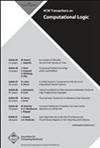一种有界度模型变化中的快速性能测试仪
IF 0.9
4区 数学
Q3 COMPUTER SCIENCE, THEORY & METHODS
引用次数: 0
摘要
性能测试算法是具有概率准确性保证的高效算法。对于属性P,目标是通过仅查询输入的少量局部部分,以高概率正确区分具有P的输入和远没有P的输入。在图的属性测试中,距离是通过将图转换为具有属性P的图所需的边缘修改(添加或删除)的数量来衡量的。许多研究都集中在这种算法的查询复杂性上,即算法对输入进行的查询数量,但从应用的角度来看,算法的运行时间同样相关。在(Adler,Harwath,STACS 2018)中,引入了性质测试的有界度图模型对有界度关系数据库的自然扩展,并表明在有界度和有界树宽的数据库上,在具有计数的一元二阶逻辑(CMSO)中表示的每一个性质都是可测试的,其查询复杂度和运行时间不变。是否可以将其改进为恒定的运行时间仍悬而未决。在本文中,我们介绍了一种新的模型,它基于有界度模型,但距离度量允许边(元组)修改和顶点(元素)修改。我们证明了在具有相同查询复杂度和运行时间的情况下,在经典模型中可测试的每个属性在我们的模型中都是可测试的,但反之亦然。我们的主要定理表明,在有界度和有界树宽的数据库上,CMSO中可表达的每一个性质在新模型中都是可测试的,具有恒定的查询复杂度和恒定的运行时间。我们的证明方法包括具有该性质的数据库的邻域直方图的半线性性,以及Alon(Lovász,Large networks and graph limits,2012中的19.10命题)的一个结果,该结果指出,对于每个有界度图\。从(Benjamini et al.,Advances in Mathematics 2010)中的一个结果可以得出,在经典模型中(因此在新模型中),超有限遗传性质可以在恒定的查询复杂度和恒定的运行时间下进行测试。使用我们的方法,我们给出了一个替代的证明,即在新模型中,超有限遗传属性在恒定的查询复杂度和恒定的运行时间下是可测试的。我们认为我们的模型是自然的,并且我们的元定理显示了恒定时间CMSO可测试性支持这一点。本文章由计算机程序翻译,如有差异,请以英文原文为准。
Faster Property Testers in a Variation of the Bounded Degree Model
Property testing algorithms are highly efficient algorithms that come with probabilistic accuracy guarantees. For a property P, the goal is to distinguish inputs that have P from those that are far from having P with high probability correctly, by querying only a small number of local parts of the input. In property testing on graphs, the distance is measured by the number of edge modifications (additions or deletions) that are necessary to transform a graph into one with property P. Much research has focused on the query complexity of such algorithms, i. e., the number of queries the algorithm makes to the input, but in view of applications, the running time of the algorithm is equally relevant. In (Adler, Harwath, STACS 2018), a natural extension of the bounded degree graph model of property testing to relational databases of bounded degree was introduced, and it was shown that on databases of bounded degree and bounded tree-width, every property that is expressible in monadic second-order logic with counting (CMSO) is testable with constant query complexity and sublinear running time. It remains open whether this can be improved to constant running time. In this article we introduce a new model, which is based on the bounded degree model, but the distance measure allows both edge (tuple) modifications and vertex (element) modifications. We show that every property that is testable in the classical model is testable in our model with the same query complexity and running time, but the converse is not true. Our main theorem shows that on databases of bounded degree and bounded tree-width, every property that is expressible in CMSO is testable with constant query complexity and constant running time in the new model. Our proof methods include the semilinearity of the neighborhood histograms of databases having the property and a result by Alon (Proposition 19.10 in Lovász, Large networks and graph limits, 2012) that states that for every bounded degree graph \(\mathcal {G}\) there exists a constant size graph \(\mathcal {H}\) that has a similar neighborhood distribution to \(\mathcal {G}\) . It can be derived from a result in (Benjamini et al., Advances in Mathematics 2010) that hyperfinite hereditary properties are testable with constant query complexity and constant running time in the classical model (and hence in the new model). Using our methods, we give an alternative proof that hyperfinite hereditary properties are testable with constant query complexity and constant running time in the new model. We argue that our model is natural and our meta-theorem showing constant-time CMSO testability supports this.
求助全文
通过发布文献求助,成功后即可免费获取论文全文。
去求助
来源期刊

ACM Transactions on Computational Logic
工程技术-计算机:理论方法
CiteScore
2.30
自引率
0.00%
发文量
37
审稿时长
>12 weeks
期刊介绍:
TOCL welcomes submissions related to all aspects of logic as it pertains to topics in computer science. This area has a great tradition in computer science. Several researchers who earned the ACM Turing award have also contributed to this field, namely Edgar Codd (relational database systems), Stephen Cook (complexity of logical theories), Edsger W. Dijkstra, Robert W. Floyd, Tony Hoare, Amir Pnueli, Dana Scott, Edmond M. Clarke, Allen E. Emerson, and Joseph Sifakis (program logics, program derivation and verification, programming languages semantics), Robin Milner (interactive theorem proving, concurrency calculi, and functional programming), and John McCarthy (functional programming and logics in AI).
Logic continues to play an important role in computer science and has permeated several of its areas, including artificial intelligence, computational complexity, database systems, and programming languages.
The Editorial Board of this journal seeks and hopes to attract high-quality submissions in all the above-mentioned areas of computational logic so that TOCL becomes the standard reference in the field.
Both theoretical and applied papers are sought. Submissions showing novel use of logic in computer science are especially welcome.
 求助内容:
求助内容: 应助结果提醒方式:
应助结果提醒方式:


